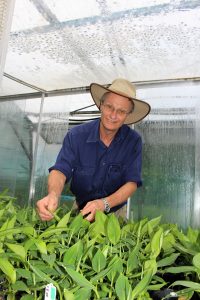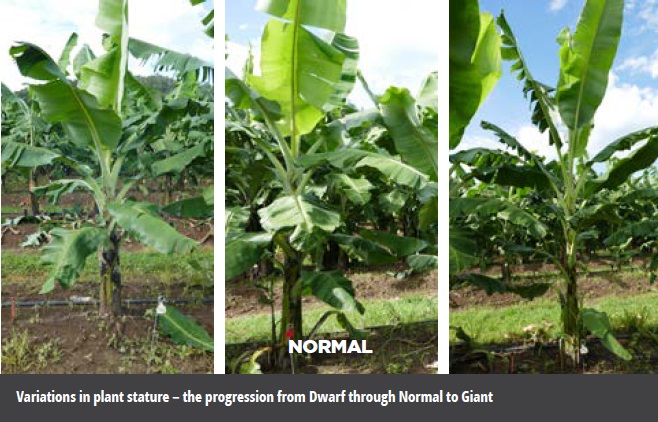By Jeff Daniells, Katie Ferro, Massimo Bianco and Sharon Hamill – Queensland Department of Agriculture and Fisheries
Queensland DAF gives an update on progress with the irradiated Goldfinger plants being evaluated at South Johnstone Research Station.
The trial plants so far exhibit an amazing array of variations in plant and bunch characteristics.
The coming months will reveal if the all-important changes sought in postharvest characteristics are realised. Here is the story so far.
Scene 1 – Jupiter’s Casino 10 May 1995. Enter stage left. “Goldfinger – the banana with the Midas touch”
With much song and dance, the banana variety Goldfinger was released to the Australian banana industry at the inaugural Australian Banana Industry Congress on the Gold Coast.

After a promising start and plantings which eventually grew to about 120 ha by 2001, Goldfinger fell from prominence in 2009 when the big supermarkets removed it from their shelves. The reasons primarily for this were insufficient attention to the market research which had been undertaken and an inadequate marketing effort following this.
Scene 2 – Tully March 2015. Enter TR4 – Cavendish banana ‘Predator’
As part of the R&D response to the incursion of TR4 in north Queensland, the Hort Innovation project BA14014 ‘Fusarium Wilt Tropical Race 4 Research Program, commenced that year with funding from the Queensland and Australian governments.
Since TR4 resistant varieties are seen by many as the ultimate solution to the problem, the BA14014 project has as a component, mutagenesis§.
Mutagenesis is about creating bananas that are different in form directly from a particular variety, and in this project gamma irradiation of tissue culture plants was used to bring about such change.
Goldfinger was chosen as a candidate for mutagenesis because it has already been demonstrated as having resistance to TR4.
It was hoped that its fruit eating characteristics could be improved by mutagenesis whilst retaining its TR4 resistance.
Scene 3 – South Johnstone Research Station June 2017 – Enter transformed Goldfinger
The mutation work is being carried out by Sharon Hamill and the Tissue Culture Team at the DAF Maroochy Research Facility QBAN Tissue Culture Laboratory.
Tissue culture plantlets of Goldfinger were taken by Sharon Hamill for irradiation treatment using UQ’s gamma cell unit at St Lucia in October 2016.
After exposure to gamma irradiation the tissue cultured plants were then stabilised back at DAF’s Maroochy Research Facility for four multiplication subculture cycles so that buds exposed to irradiation and hence changed, could develop into shoots and to minimise the incidence of chimeras. (A chimera, in this case, refers to a plantlet consisting of two or more tissues of different genetic/ epigenetic composition which is unstable but temporary in nature.)
Finally plants were subcultured onto media for elongation and root development and then despatched to South Johnstone as two fairly similar sized shipments – in June and August of last year – to help spread the fruit assessment workload and make things more manageable.
In total, including Goldfinger controls, there were just over 700 plants. In regard to postharvest characteristics, we are particularly seeking a firmer fruit pulp, longer shelf life and perhaps a sweeter and creamier texture. Differences in plant and bunch characteristics may be potentially useful as well.
Variations have so far been evident in plant stature and degree of dwarfness; leaf angle; pigmentation of leaf lamina, midrib, petiole and pseudostem; bunch angle; finger length; flower and bract retention on the stalk below the bunch; and bell shape.
Some of the irradiated plants will be rejected due to gross deformities and extremely slow growth.
About 13% of the irradiated plants are currently in this reject category.
The photos in this article show just a sample of the large range of variants so far obtained.
These alterations in form of the irradiated Goldfinger could be due to genetic or epigenetic changes. An epigenetic change is one caused by modification of gene expression rather than alteration of the genetic code itself, and can be heritable also.
We’ve only just begun to harvest bunches in the trial and this will continue for the remainder of 2018. Any selections with improved fruit characteristics will be tissue cultured and then screened against TR4 in the Northern Territory to confirm TR4 resistance has been retained.
Concurrently ten plants of each selection will be established at South Johnstone from sucker and bit material to obtain replicated data sets for a plant crop and ratoons.
Whilst the broad range of changes in plant characteristics so far achieved is very encouraging, it is still nevertheless very early days in the assessment.
But let’s hope that we find an improved Goldfinger amongst those irradiated which does eventually bring success, profitability and enviable results as the Midas touch implies.
More background information about Goldfinger is available at http://www.promusa.org/FHIA-01.
Read more about the overall mutagenesis program in an article by Stewart Lindsay, ‘Pursuit for Panama Resistant Varieties’ published in the December 2017 edition of Australian Bananas and available on line at www.abgc. org.au
This project has been funded by Hort Innovation with co-investment from Queensland Government and contributions from the Australian Government. Hort Innovation is the grower-owned, not-for-profit research and development corporation for Australian horticulture.





